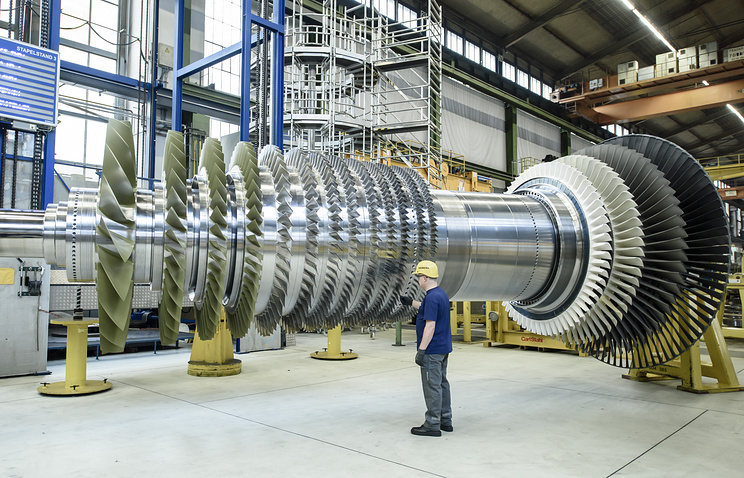The European Union announced the expansion of the sanctions list against Russia in connection with the scandal surrounding the supply of Siemens turbines to the Crimea. The black list included three physical persons and three legal entities, including the Deputy Minister of Energy Andrei Tcherezov.
TASS talks about the nature of the scandal, the actions taken by Siemens, as well as about the turbines themselves, their purpose and the exceptional importance for the republic.
What are the purposes of supplying turbines to the Crimea?
They will be installed at two TPPs, which are currently being built in Sevastopol and in Simferopol. Before the reunification of the Crimea with Russia, about 80% of electricity to the peninsula came from the territory of Ukraine. Now the Russian authorities create conditions that will enable the Crimea to generate the necessary amount of energy. The total demand for the peninsula in electricity is 1,350 MW, and by 2021 due to the development of the region's economy it will double.
Why the peninsula own generation?
Back in 2014, within the framework of the Federal Target Program "Social and Economic Development of the Crimea", a decision was made to create an energy bridge "Crimea-Kuban", which would supply electricity from Rostov NPP to the peninsula, and build two gas-turbine thermal power plants.
For the time of construction, the Ukraine had to provide the peninsula with energy - it was signed with the corresponding agreement. However, in October 2015, unknown persons undermined one of the power transmission line supports linking Ukraine and Crimea. A month later, the rest of the pillars were blown up. Crimea ceased to receive electricity from outside.
By the time the Crimea provided itself with electricity only 35%. On the peninsula fan outages of electricity began. EMERCOM of Russia provided generators for the uninterrupted supply of energy to hospitals. Nevertheless, there were some consequences. Did not work kindergartens, trolley buses stopped, light in residential houses was given for 4-8 hours a day.
Overcoming the energy crisis in the region was succeeded in December 2015, when two lines of the energy bridge were successively launched. Completely to cover Crimea's need for energy was possible by May 2016, when all four lines of the energy bridge were launched.
If there is an energy bridge, why do we need new thermal power plants?
The energy now supplied is sufficient to meet the current needs of the peninsula. But it is obvious that as the economy of the region develops, electricity consumption will grow. The total capacity of the new TPP will be 940 MW, which will allow to avoid the energy deficit with any increase in consumption.
Both stations are being built by a subsidiary of Rostecha - JSC "Foreign Economic Association" Tekhnopromexport ".
Why there was a conflict around the supply of turbines for TPP?
Initially, it was planned to install turbine units at the stations, which are manufactured at the company "Siemens Gas Turbine Technologies" in St. Petersburg. This joint venture is Siemens (owns 65% of shares) and PJSC Power Machines (35% of shares). However, this would cause problems for the German company, because because of sanctions, the EU companies have no right to supply their products to the Crimea.
In February, Rostech tried to agree on the supply of turbines from Iran, but the deal did not take place.
OOO "Siemens gas turbine technology" eventually sold its equipment to an unnamed Russian buyer on the condition that it will be used in the Krasnodar Territory, and not in the Crimea.
In early July, Reuters reported, citing a source, that two German turbines were delivered to the Crimean facility. The contractor for the construction of the TPP said that the turbines were purchased on the secondary market and modernized by Russian factories and engineering companies.
Nevertheless, in the concern Siemens, the supplies of turbines to the Crimea were considered a violation of contractual obligations and demanded that the equipment be returned to the territory of the Krasnodar Territory.
On July 11, Russian Industry and Trade Minister Denis Manturov told reporters on the sidelines of the international industrial exhibition "Innoprom-2017" that Simferopol and Sevastopol TPP will be equipped with Russian turbines "using elements of foreign production." In an interview with TASS, he explained that the Russian side has ensured maximum legal correctness when using Siemens technologies in the production of turbines for thermal power plants in the Crimea. According to him, turbines have a "Russian certificate".
Now the disagreement between the parties should be resolved by the court, which Siemens addressed.
What was Siemens's response to the supply of turbines?
Without waiting for the court's decision, Siemens decided to stop participation (46%) in the Russian company Interavtomatika. This company was one of the contractors involved in installing turbines. Also, Siemens will withdraw or replace two of its employees who are members of the supervisory board of Interautomatica for the duration of the investigation.
The implementation of certain contracts with firms with state participation in Russia will also be suspended. "Siemens has so far stopped existing contracts with government-controlled customers in Russia for the supply of components for power plants



